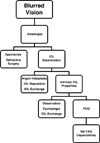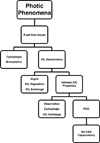Dissatisfaction after multifocal intraocular lens implantation
- PMID: 19465282
- PMCID: PMC5125020
- DOI: 10.1016/j.jcrs.2009.01.031
Dissatisfaction after multifocal intraocular lens implantation
Abstract
Purpose: To analyze the reasons for patient dissatisfaction after phacoemulsification with multifocal intraocular lens (IOL) implantation and the outcomes after intervention.
Setting: Emory Eye Center, Atlanta, Georgia, USA.
Methods: This retrospective review comprised eyes of patients dissatisfied with visual outcomes after multifocal IOL implantation. Outcomes analyzed included type of visual complaint, treatment modality for each complaint, and degree of clinical improvement after intervention.
Results: Thirty-two patients (43 eyes) reported unwanted visual symptoms after multifocal IOL implantation, including in 28 eyes (65%) with an AcrySof ReSTOR IOL and 15 (35%) with a ReZoom IOL. Thirty patients (41 eyes) reported blurred vision, 15 (18 eyes) reported photic phenomena, and 13 (16 eyes) reported both. Causes of blurred vision included ametropia (12 eyes, 29%), dry eye syndrome (6 eyes, 15%), posterior capsule opacification (PCO) (22 eyes, 54%), and unexplained etiology (1 eye, 2%). Causes of photic phenomena included IOL decentration (2 eyes, 12%), retained lens fragment (1 eye, 6%), PCO (12 eyes, 66%), dry-eye syndrome (1 eye, 2%), and unexplained etiology (2 eyes, 11%). Photic phenomena attributed to PCO also caused blurred vision. Thirty-five eyes (81%) had improvement with conservative treatment. Five eyes (12%) did not have improvement despite treatment combinations. Three eyes (7%) required IOL exchange.
Conclusions: Complaints of blurred vision and photic phenomena after multifocal IOL implantation were effectively managed with appropriate treatment. Few eyes (7%) required IOL exchange. Neodymium:YAG capsulotomy should be delayed until it has been determined that IOL exchange will not be necessary.
Figures
Comment in
-
Complications of multifocal intraocular lenses: What have we learned?J Cataract Refract Surg. 2021 Oct 1;47(10):1256-1257. doi: 10.1097/j.jcrs.0000000000000777. J Cataract Refract Surg. 2021. PMID: 34544084 No abstract available.
References
-
- Pepose JS, Qazi MA, Davies J, Doane JF, Loden JC, Sivalingham V, Mahmoud AM. Visual performance of patients with bilateral vs combination Crystalens, ReZoom, and ReSTOR intraocular lens implants. Am J Ophthalmol. 2007;144:347–357. - PubMed
-
- Jacobi FK, Kammann J, Jacobi KW, Großkopf U, Walden K. Bilateral implantation of asymmetrical diffractive multifocal intraocular lenses. Arch Ophthalmol. 1999;117:17–23. - PubMed
-
- Chiam PJT, Chan JH, Haider SI, Karia N, Kasaby H, Aggarwal RK. Functional vision with bilateral ReZoom and ReSTOR intraocular lenses 6 months after cataract surgery. J Cataract Refract Surg. 2007;33:2057–2061. - PubMed
-
- Leyland M, Pringle E. Multifocal versus monofocal intraocular lenses after cataract extraction. [Accessed February 27, 2009];Cochrane Database Syst Rev. 2006 (3) art. no. CD003169. CD003169. pub2. Available at: http://www.cochrane.org/reviews/en/ab003169.html. - PubMed
-
- Pineda-Fernández A, Jaramillo J, Celis V, Vargas J, DiStacio M, Galíndez A, Del Valle M. Refractive outcomes after bilateral multifocal intraocular lens implantation. J Cataract Refract Surg. 2004;30:685–688. - PubMed
Publication types
MeSH terms
Grants and funding
LinkOut - more resources
Full Text Sources
Other Literature Sources
Medical



